Kashmir (or Cashmere as pronounced by Europeans) is very well known as “The Paradise on Earth”. And that is owed to its abundant scenic beauty which each and every visitor cherishes. Kashmir is a treasure trove of natural splendors, and one cannot stop one from visiting the valley again and again. Majestic mountain peaks, pristine rivers, untouched valleys, and people filled with love and compassion for you; that is what you get to see on your every visit to Kashmir.
Kashmir is the perfect combination of natural spectacles and man-made treasures. Art and craft are a part and parcel of this beautiful valley. Artisans of Kashmir have excelled in hand-making art marvels and sharing them with the entire world. The grandeur of their handmade articles and their artful bent of mind has always been appreciated by patrons around the globe. Be it their creativity in making Papier Mache items, their immense skill in wood carving, their meticulousness when it comes to carpet weaving, or their crafty imagination in any craft that the valley accommodates, these craftsmen are the true masters. But there has been one single winner in the handicraft industry of Kashmir, which crossed all borders since it was discovered for the first time. And that is Pashmina shawl making.
Where does Cashmere come from?
Cashmere comes from Ladakh, where a rare species of goats grows it over its body. It is Cashmere wool that is the actual hero. Let’s go through the origin, processing, and finishing of Cashmere. Let's see how this lump of wool helps to create magic in the form of warm winter wraps and accessories
What is Cashmere made of? Origin of Cashmere Wraps
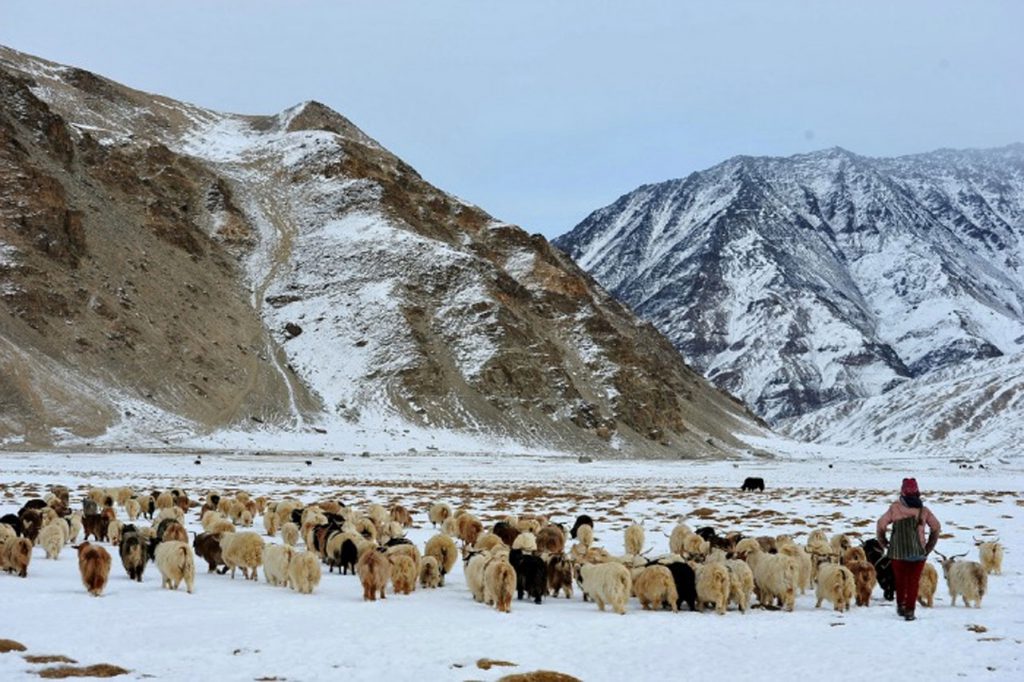
Cashmere fleece is found in Ladakh, where the Changthangi goat resides. The area has harsh climatic conditions and the temperature in winter dips as low as -40 degrees. To protect the Changthangi goat from such conditions, nature has bestowed it with Cashmere wool. Cashmere grows on its underbelly and keeps it warm in the harshest of weather. In fact, the only reason that the goat is able to roam about freely even in the peak winter season is the protection provided to it by Cashmere.
However, as soon as summer arrives, the goat becomes uncomfortable. That is because the wool is exceptionally warm, and now unbearable for it. This makes the goat rub itself against rough surfaces like shrubs, rocks, and walls to get rid of this wool. Herders take note of the situation and immediately call for professional help. Professionals bring along specialized tools like large toothed combs, fine-toothed combs, and other tools to gently comb the wool off the goat’s body. This raw wool is Cashmere (locally called Pashm). It is collected and put into small zip-lock packets. Later it is cleaned by local men and women, and a partially cleaned batch of wool is sent to Kashmir for further processing.
Also read: All You Need to Know About the Pashm Fibre - Pashmina Wool
Processing of semi-cleaned lumps of wool
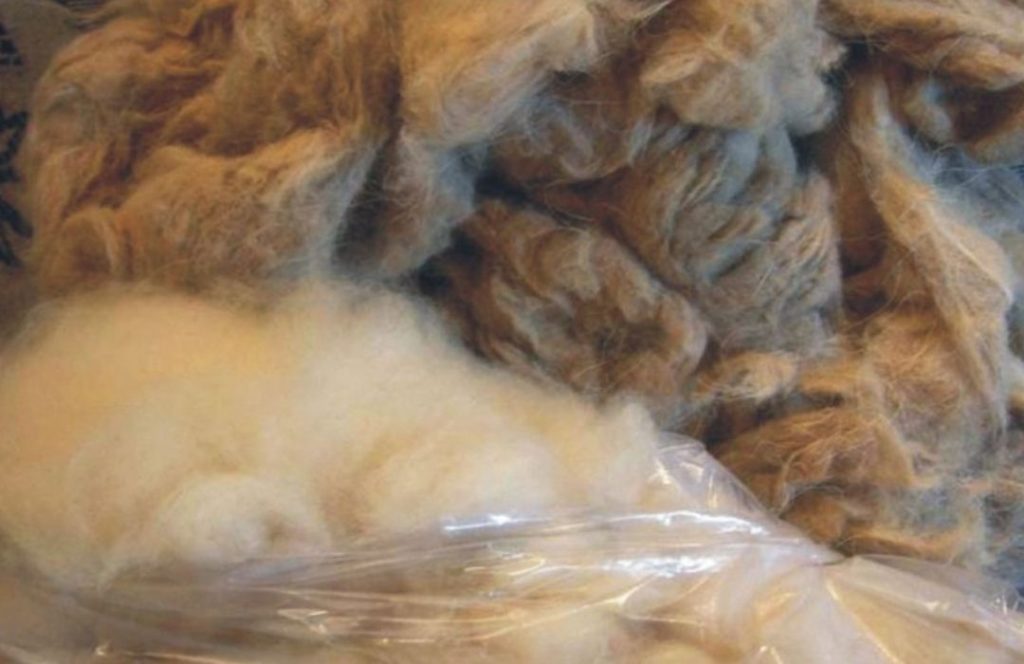
When the raw wool arrives in Kashmir, it is handed over to womenfolk. They sit in groups and start with the cleaning of raw fibre. Raw fibre is full of dirt, dust, and foreign material which gets attached to the animal as it moves around. Impurities like vegetable wastes, grass, dirt, thorns of bushes are found to be mixed with this fibre. Besides guard hair is still mixed with pure threads. The wool is cleaned thoroughly and placed in a container, filled with rice powder, for 3 to 4 days.
Womenfolk from all parts of the valley come together and begin the process of spinning. This is done by fitting the raw wool in a wooden spinning wheel locally known as "Yinder". Spinning the wool transforms the raw wool into long threads or yarn. The yarn is so fine; its diameter is 12-16 microns only.
The yarn is then handed over to weavers. Weavers are usually men, who sit two at a time on a wooden handloom that is native to Kashmir. Men mount the fine yarn on the handloom and begin weaving into fabric. This fabric can be made into a shawl, wrap, scarf or handkerchief even. This is how Cashmere shawls are made from Cashmere wool
Embroidering Cashmere Wraps
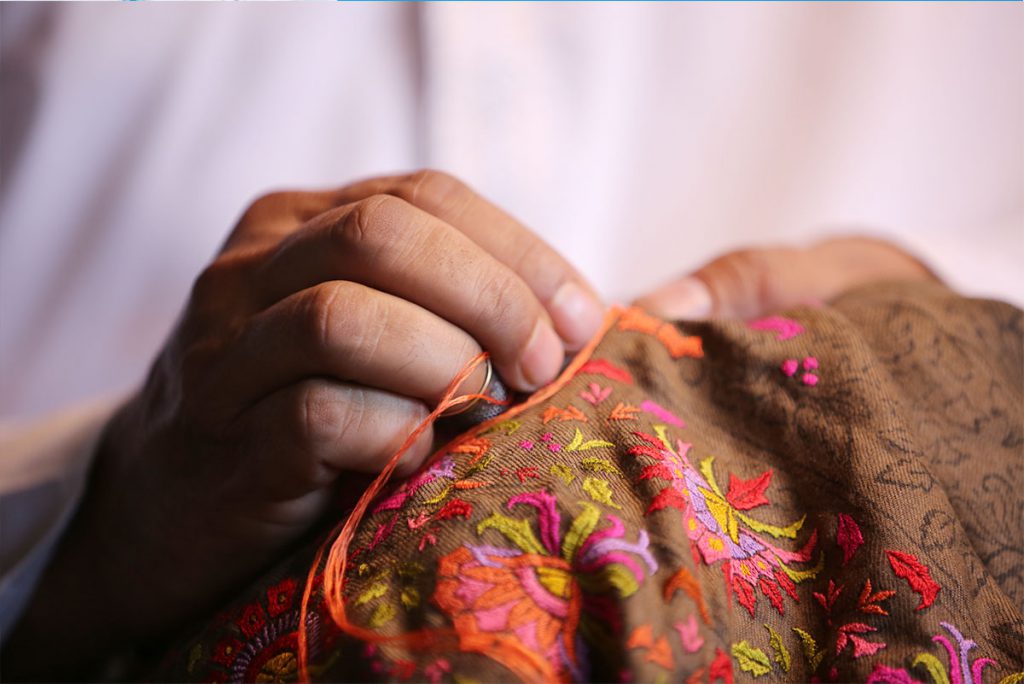
Since Cashmere is fine and delicate, it stands only for hand embroidery. There are several types of hand embroidery that are done over Cashmere wraps. This makes them more beautiful, and resplendent to look at.
- Sozni Kari: Sozni is a fine thread and needlework which is done over the wrap manually inch by inch. Sozni can be done all over the wrap, or just the borders.
- Paper Mache Embroidery: A thicker thread and needle are used to make opulent, colourful patterns on a shawl in this type. The end product simply looks like a painting.
- Tilla Embroidery: Tilla used metal threads dipped in gold or silver. This embroidery becomes heavy for a Cashmere wrap and is hence done over borders or as booties running all over the base.
With times changing and younger generations finding embroidered shawls overdone for them, Cashmere adapted to modish patterns and introduced some casual designs.
Modern Design Wraps
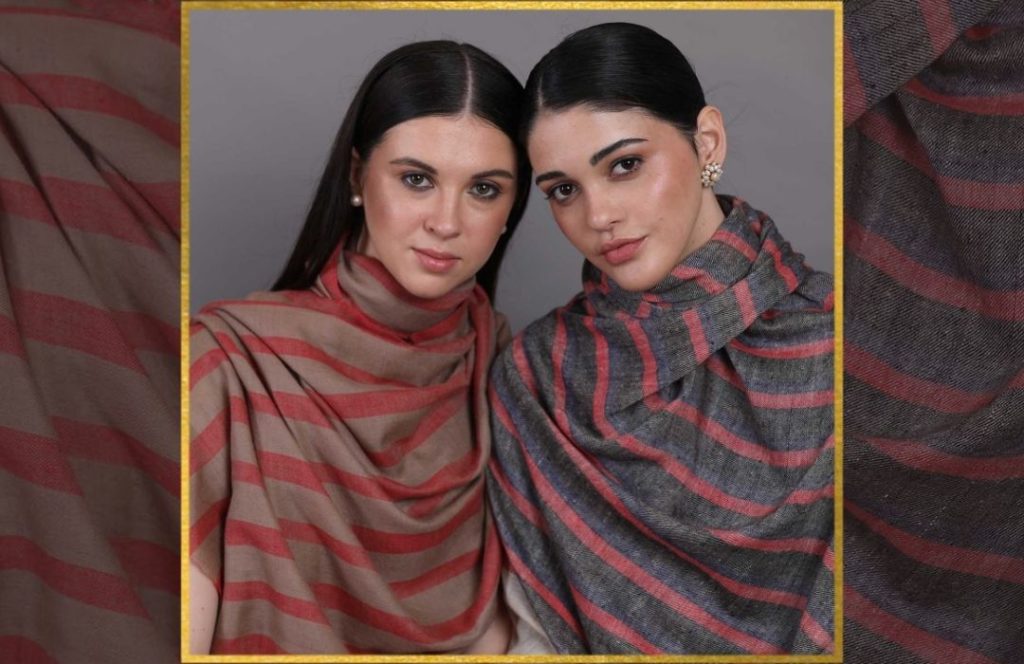
- Solids: Plain Cashmere wraps are loved by women of all generations, ages, and temperaments. Solid wraps have beautiful colours, pastels, and brights, making them perfect for almost all occasions. Be it office, casual get-together, nights out with friends or family, or visiting your grandparents, solid Cashmere wraps are the first choice in Winters, spring, and fall.
- Printed and Patterned Cashmere wraps: If you aren't a fan of plains, Cashmere has chic stripes, checks, plaids, and abstract patterns for you. Besides these, Cashmere wraps now host animal prints, floral prints, and even customizable prints and patterns. These are perfect for dates, meetings with clients, or as birthday gifts.
- Laced Cashmere wraps: This category of Cashmere wraps is something perhaps the bridesmaids were looking for. Dainty French Laces have been hand-stitched onto the base of a wrap which makes it look pretty and feminine enough to be worn as a bridesmaid, or gifting it to one.
Also read: What does Cashmere feel like?
Cashmere Scarves
In addition to being useful accessories, cashmere scarves are opulent items that provide warmth and coziness to any ensemble. The smooth and delicate texture of these scarves, which are made from the finest Cashmere fibers, makes them ideal for wrapping around the shoulders or neck. They are adaptable, going from comfortable daily wear to sophisticated evening wear with ease thanks to their rich texture and lightweight nature. A cashmere scarf instantly boosts style and sophistication, whether it's worn with a basic sweater or a fitted coat.
Cashmere scarves are a great medium for artistic expression because they are available in a wide range of hues, designs, and weaves. Every personality and situation can be suited by a Cashmere scarf, which comes in vivid flower motifs, intricate paisley designs, and classic solid tones. Because of the elaborate artistry that goes into its manufacture, each piece is unique and frequently incorporates artisanal skills like hand-looming or delicate stitching. Because of their adaptability, fashionistas may combine scarves with various ensembles to create fresh styles and highlight their own style.
Cashmere scarves are not only beautiful and functional, but they also have a timeless appeal that goes beyond fads. Purchasing a premium cashmere scarf entails accepting an item that will represent style and sophistication for many years to come in addition to offering warmth. A Cashmere scarf, whether given as a considerate present or as a personal treat, is a treasured piece that elevates regular clothing into something genuinely unique, beckoning wearers to enjoy in the opulent comfort and style that only Cashmere can offer.
Pashmina Shawls crafted from finest Cashmere
The finest Cashmere fibers are used to create Pashmina shawls, which are the pinnacle of luxury and beauty in textile design. These shawls are manufactured from the silky undercoat of Pashmina goats, who are known to produce some of the most exquisite and delicate fibers available, and have their origins in the high-altitude regions of the Himalayas. The artists who weave each shawl, who frequently use age-old techniques that have been handed down through the years, are a monument to their talent and creativity. The end product is a fabric that is lightweight, extremely soft, and warm, making Pashmina shawls ideal for layering throughout the year.
Pashmina shawls are beautiful not just because of their material but also because of their elaborate details and gorgeous designs. These shawls, which are frequently embellished with exquisite designs like paisleys, flowers, or delicate stitching, highlight the rich cultural legacy of their place of origin. The painstaking weaving and hand-embroidery procedures that give each piece life demonstrate the artistry required to create a Pashmina shawl. These shawls are adaptable accessories that can enhance any ensemble, from casual to formal wear, thanks to their vivid colors and detailed patterns, which offer countless style options.
Beyond their visual appeal, Pashmina shawls are a sustainable option, particularly if they come from ethical producers who place a high value on animal welfare and ethical husbandry. In order to produce this opulent material, the goats are treated humanely during the meticulous collection procedure of Pashmina fibers. Purchasing a Pashmina shawl not only allows you to enjoy a work of beautiful craftsmanship, but it also supports environmentally friendly and sustainable techniques that honor the craftspeople who spend their lives upholding this ancient custom. More than just an accessory, a Pashmina shawl is a classic item that perfectly captures the elegance, culture, and beauty of premium cashmere.
History
The history of Cashmere is interesting enough to be made into a movie. It has watched ups and downs and then finally perished, only to be revived again. The world, especially Europeans, have a special relation with Cashmere because they are the ones who invented the term “Cashmere” as an anglicisation of the word Kashmir. And their countries were the first ones who manufactured their own Cashmere wraps, with their own unique designs. However, even then, the wealthier ones among them still preferred Cashmere from Kashmir, as it was the best in terms of quality, warmth, and grace.
It was around the 16th century when Cashmere was discovered for the first time in Kashmir. A Sufi saint by the name of Mir Syed Ali Hamdani discovered fine wool in Ladakh and ordered craftsmen to handcraft a pair of socks from it. When the order was complete, the saint was mesmerized by it. He gave it as a gift to the then ruler of Kashmir Zain ul Abideen. The king was impressed, so much so, that he ordered manufacturing units to be set in the valley for processing Cashmere. As a matter of fact, he invited hundreds of craftsmen from Iran and ordered them to train the locals in Cashmere shawl making.
Prominence in Europe
Not only in Kashmir, Cashmere wool gained prominence all over the world when the news of its grandeur spread. Europeans visited the valley, and later started trade between the two nations. France was the first country to order Cashmere shawls from Kashmir, which in turn increased foreign demand of the shawls, making Kashmir economically strong, and artisans one of the most wealthy communities.
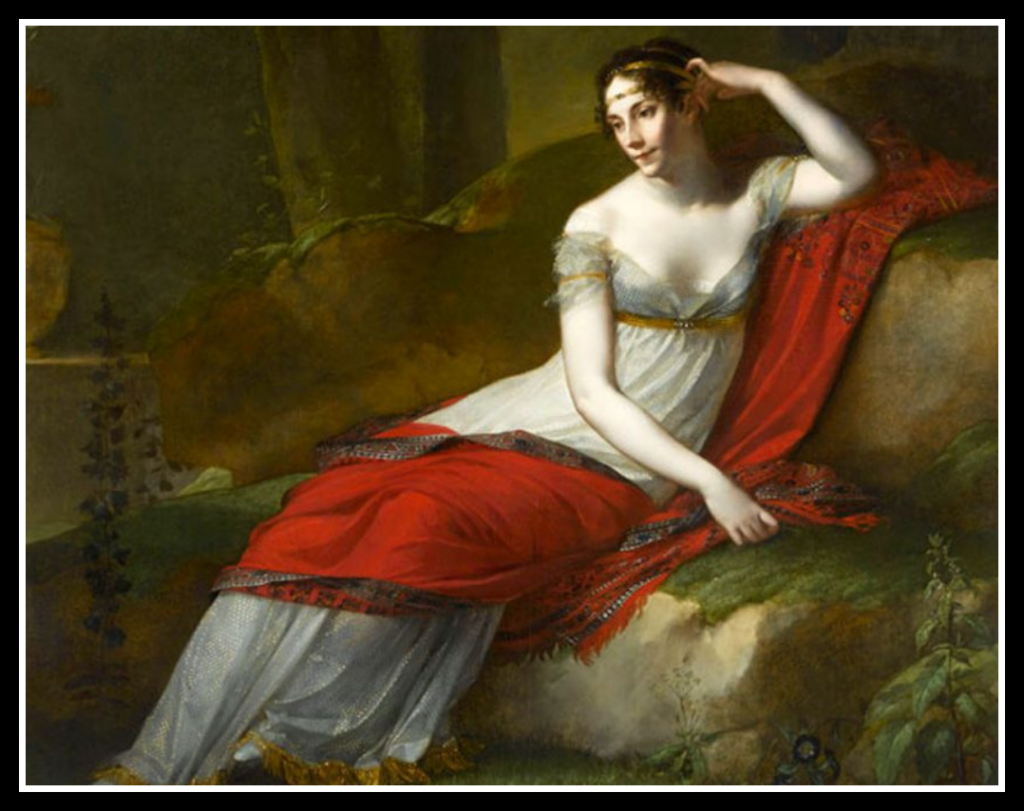
Later Scotland too traded Cashmere, and started their own units to process Cashmere. Cashmere shawls were set in a timeless fashion by Empress Josephine who owned hundreds of Kani Pashmina shawls after she was gifted one by her husband Napoleon. Kings in Persia too considered Cashmere wraps as holy and used to give Pashmina shawl to rulers of other countries as gifts. They called it ‘Khilat’. Hence Cashmere wraps traveled all over the world, and visitors from Australia, Central Asia, the Middle East, Europe used to visit the valley just to buy Pashmina shawls.
Cashmere vs. Pashmina | What is the difference between Cashmere and Pashmina?
For so many years now, there has been this confusion about Cashmere and how it is different from Pashmina. We have been asked this question multiple times, “What is the difference between Cashmere and Pashmina?”. So today we answer all questions regarding the differences and similarities between the two terms.
While Cashmere is the wool that is used to make Pashmina shawls, Pashmina is the name given to the art of handcrafting luxury wraps from Cashmere fibre. The art of Pashmina includes spinning and weaving cashmere, the downy undercoat of the Changthangi goat to make luxury shawls, scarves, stoles, and more. Hence Cashmere is the raw material, and the complete shawl is called Pashmina shawl, albeit locally. Globally even Pashmina shawl is called Cashmere wrap.
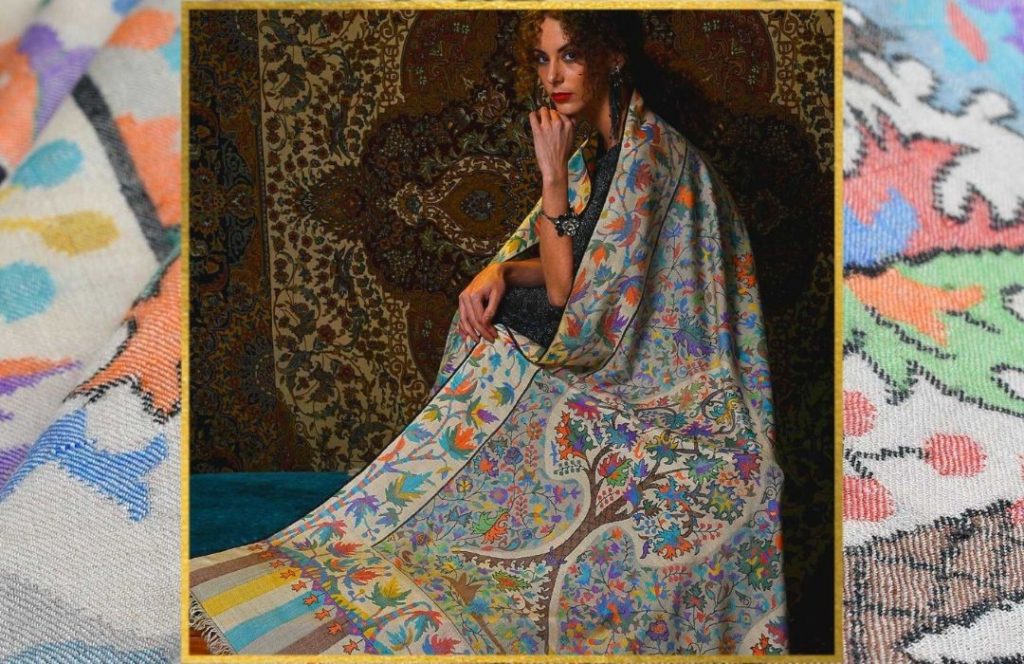
Pashmina is a local term. It comes from the Persian word ‘Pashm” which means ‘Soft Gold’. Just because a Persian Saint discovered it, he began calling it Pashm, as it was soft wool and exceptionally treasured and precious. Hence the term Pashmina can be understood in Kashmir or India.
Cashmere is the term Europeans coined when they could pronounce Kashmir as locals would. They used the term to describe the wool which comes from Ladakh.
The alleged cruelty factor
Are goats killed for Cashmere?
Is Cashmere banned?
Should we buy Cashmere?
Is Cashmere worth it?
These are some common questions that are continuously asked by customers, mostly those who are responsible citizens of the planet and abhor animal cruelty and that done towards the planet. People want to know if they are investing hundreds or sometimes thousands of dollars for buying a Cashmere wrap, which is worth the money. Or are they contributing towards the destruction of the planet?
However, the answer to all these questions is NO. Cashmere is cruelty-free, and goats are not killed for Pashmina shawl production, and hence Cashmere is not banned. To know the reason for the ban on this kind of wool, we today dig deep into the making of Pashmina shawls and see for ourselves why it is cruelty-free and ethical to have.
Cashmere is acquired from Ladakh where it is grown as an undercoat over the body of the Ladakhi Changthangi goat. The goat naturally grows the wool over its body in winters and it protects the goat from the freezing cold outside. (the temperature goes down to -50 degrees). But as soon as summer arrives, the goat becomes too uneasy and itself rubs its body with rough surfaces to get rid of it, which is not possible completely. Herders come to its rescue and professionals gently comb off the wool from its body. This is early summer, and not the winter season. Moulting season is Spring to Summer. This wool is fine Cashmere, and upon processing it is converted to Pashmina shawls, stoles, scarves, and even apparel.
Reasons for Pashmina being ethical and cruelty-free
First and foremost, Cashmere goats are domestic. It is Shahtoosh which is unethically obtained because Chiru goat is a wild animal and it has to be killed in order to obtain its wool i,e, Shahtoosh.
Pashmina goats themselves need to get rid of the wool. It is necessary to remove the wool from their bodies as it might be dangerous to carry this burden in the hot summer season.
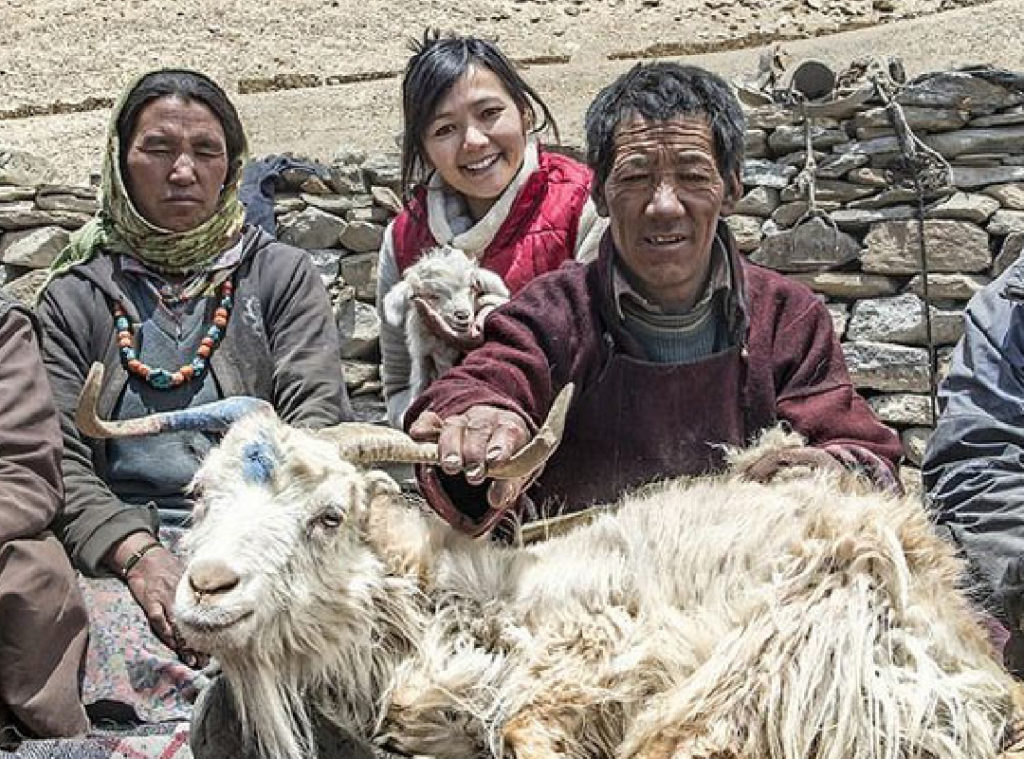
Pashmina is not cruel. Pashmina goats are not killed for the wool. They aren't even slightly harmed, as the wool is combed off and not sheared. Besides, they are domestic animals, and very well know about the process of combing off their wool.
The ban on Shahtoosh shows that it is Shahtoosh that is unethical. Pashmina has never been banned. In fact, it is traded all over the world.
The practice of using traditional methods and processes makes Cashmere wraps highly durable, and pure pieces can last for even 30 years. It is a tradition in Kashmir, that when a bride is about to leave her place, her mother enshrouds her in a classic Pashmina from her own treasure trove. The shawl doesn't look old, but heritage
Also read: 500 Years of Timeless Fashion - Pure Pashmina
Sustainability and Cashmere
The goal of sustainability in cashmere manufacturing is to strike a balance between the luxury of this prized material and ethical and ecologically conscious methods. The environmental effects of Cashmere goats' excessive grazing, especially in areas like Mongolia, are one of the main issues facing the cashmere industry. Due to their heavy grazing, these goats—known for creating the silky undercoat that eventually becomes cashmere—can cause soil erosion and land damage. To combat this, sustainable Cashmere projects prioritize rotational farming and managed grazing methods, which enable the land to recover and shield ecosystems from long-term harm. Producers of cashmere contribute to environmental preservation and the long-term availability of the fiber by encouraging sustainable herding methods.
Another crucial component of sustainable cashmere is animal welfare. Humane treatment of Cashmere goats is the main emphasis of ethical companies, which make sure that the animals are not hurt during the combing or shearing procedures required to gather the delicate undercoat. Furthermore, a lot of sustainable Cashmere initiatives choose smaller, locally owned farms over massive industrial production, guaranteeing that the goats are nurtured in more natural and healthful environments. In addition to enhancing the fiber's quality, this helps local herders and maintains the traditional ways of producing cashmere.